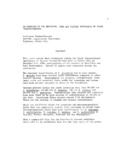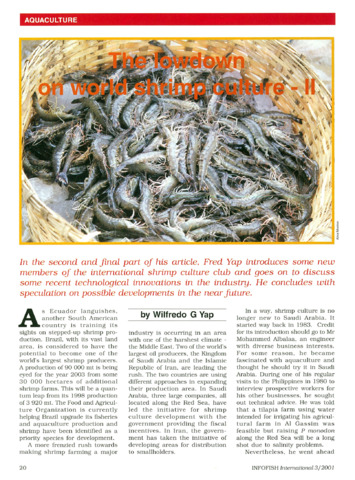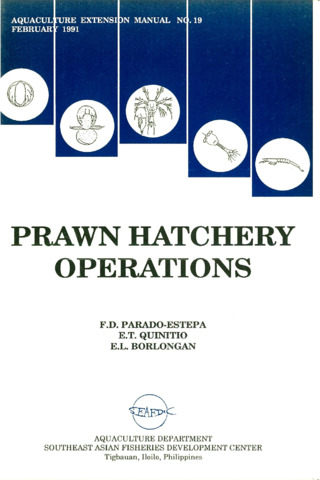Prevalence of white spot syndrome virus (WSSV) in wild shrimp Penaeus monodon in the Philippines
Share
| dc.contributor.author | de la Peña, Leobert D. | |
| dc.contributor.author | Lavilla-Pitogo, Celia R. | |
| dc.contributor.author | Villar, Corina Belle R. | |
| dc.contributor.author | Paner, Milagros G. | |
| dc.contributor.author | Sombito, Christopher D. | |
| dc.contributor.author | Capulos, Geimbo C. | |
| dc.date.accessioned | 2014-05-15T08:22:18Z | |
| dc.date.available | 2014-05-15T08:22:18Z | |
| dc.date.issued | 2007 | |
| dc.identifier.citation | de la Peña, L. D., Lavilla-Pitogo, C. R., Villar, C. B. R., Paner, M. G., Sombito, C. D., & Capulos, G. C. (2007). Prevalence of white spot syndrome virus (WSSV) in wild shrimp Penaeus monodon in the Philippines. Diseases of Aquatic Organisms, 77(3), 175-179. | en |
| dc.identifier.issn | 0177-5103 | |
| dc.identifier.uri | http://hdl.handle.net/10862/2057 | |
| dc.description.abstract | Prevalence of white spot syndrome virus (WSSV) was determined using polymerase chain reaction (PCR) methodology on DNA extracted from the gills of wild black tiger shrimp Penaeus monodon collected from 7 sampling sites in the Philippines. These 7 sampling sites are the primary sources of spawners and broodstock for hatchery use. During the dry season, WSSV was detected in shrimp from all sites except Bohol, but during the wet season it was not detected in any site except Palawan. None of the WSSV-PCR positive shrimp showed signs of white spots in the cuticle. Prevalence of WSSV showed seasonal variations, i.e. prevalence in dry season (April to May) was higher than in the wet season (August to October). These results suggest that WSSV has already become established in the local marine environment and in wild populations of P. monodon. Thus, broodstock collected during the dry season could serve as the main source of WSSV contamination in shrimp farms due to vertical transmission of the virus in hatcheries. | en |
| dc.description.sponsorship | This study was funded by the Government of Japan Trust Fund to SEAFDEC AQD under the study code GOJ-TF 6251-100-60. Thanks are due to Y. Inui, K. Nagasawa and K. Okuzawa (fish disease experts) for their guidance during the study and to M. Peniero, R. Traviña and V. Suarnaba for their technical assistance. We are very grateful to S. Alisasis, D. Aragon, M. Uy, R. Dieta, R. Abrera, R. Seballos and B. Lim, who gave us access to their farms and stations for sampling, and provided wild shrimp samples. | en |
| dc.language.iso | en | en |
| dc.publisher | Inter Research | en |
| dc.relation.uri | http://www.int-res.com/articles/dao2007/77/d077p175.pdf | |
| dc.subject | Penaeus monodon | en |
| dc.subject | Philippines | en |
| dc.title | Prevalence of white spot syndrome virus (WSSV) in wild shrimp Penaeus monodon in the Philippines | en |
| dc.type | Article | en |
| dc.citation.volume | 77 | |
| dc.citation.issue | 3 | |
| dc.citation.spage | 175 | |
| dc.citation.epage | 179 | |
| dc.citation.journalTitle | Diseases of Aquatic Organisms | en |
| dc.subject.asfa | breeding stock | en |
| dc.subject.asfa | DNA | en |
| dc.subject.asfa | White spot syndrome virus | en |
| dc.subject.asfa | gills | en |
| dc.subject.asfa | husbandry diseases | en |
| dc.subject.asfa | mariculture | en |
| dc.subject.asfa | marine crustaceans | en |
| dc.subject.asfa | nucleotide sequence | en |
| dc.subject.asfa | polymerase chain reaction | en |
| dc.subject.asfa | spawning populations | en |
| dc.identifier.essn | 1616-1580 | |
| dc.identifier.doi | 10.3354/dao01834 | |
| dc.subject.scientificName | Penaeus monodon | en |
Files in this item
| Files | Size | Format | View |
|---|
This item appears in the following Collection(s)
-
AQD Journal Articles [1215]
These papers were contributed by AQD staff to various national and international journals



